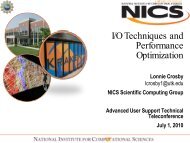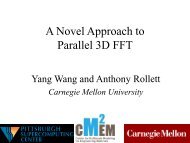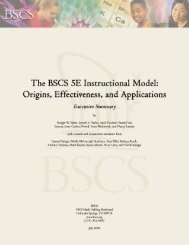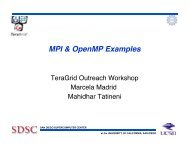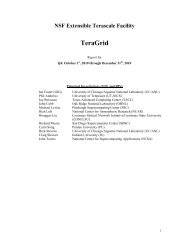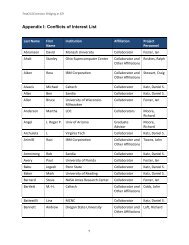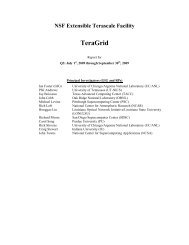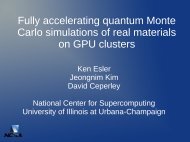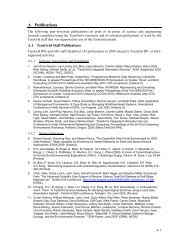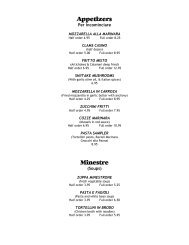TGQR 2010Q2 Report.pdf - Teragridforum.org
TGQR 2010Q2 Report.pdf - Teragridforum.org
TGQR 2010Q2 Report.pdf - Teragridforum.org
You also want an ePaper? Increase the reach of your titles
YUMPU automatically turns print PDFs into web optimized ePapers that Google loves.
• Subversion source management has resulted in better collaboration<br />
• ASTA work has allowed runtime parameters control grid size and process count as well<br />
as other IO-related settings<br />
• SPRNG random number library was added<br />
• A project wiki space was created for the project on NCSA wiki: wiki.ncsa.uiuc.edu and<br />
the wiki is being used to develop a code developer/user guide. This is very beneficial as<br />
there are always new students who need to get up to speed with the (rapidly changing)<br />
software<br />
• It is anticipated that the wiki will help with documentation and legacy support once the<br />
active development stage of the project collaboration has completed<br />
• 3D transpose routines were integrated with the existing code<br />
Darren’s main focus was to design a new HDF5 date format and optimize I/O routines. The new<br />
HDF5 code, developed at NCSA for the PI’s DNS data has these basic properties:<br />
• A lightweight c library (dubbed “h5dns”) with Fortran interface routines. The library is<br />
designed to be used both as a writer (from the dns code) and a reader (from dns code and<br />
visualization codes)<br />
• The c library only requires HDF5 (usually with MPI –“PHDF5”)<br />
• All hdf I/O routines will be optimized for parallel I/O when they are compiled with MPI<br />
• Files are intended to be “self-describing” with attributes and metadata datasets<br />
• The file format will be used for both 2D and 3D Rectilinear Grid data consisting of both<br />
scalar and 3d vector variables<br />
• Information about the per MPI-process layout of the data is preserved as supplementary<br />
metadata to the main datasets. The datasets themselves are single array spanning the<br />
global computational grid.<br />
Initial testing of basic I/O functionality and unit testing of the library are happening currently. It<br />
is expected that runs will be done in early to mid August to get new visualization dump via the<br />
HDF5 routines and it will allow to explore the data in both VisIt and with David Bock’s<br />
visualization tools.<br />
Following many tasks remain to be completed:<br />
• Fully integrate HDF5 routines with the main code<br />
• Test new data format for correctness<br />
• Create reader routine for VisIt<br />
• Integrate Isotropic turbulence code into new executable<br />
• Update code to perform 2d domain decomposition<br />
• Optimize I/O patterns both by system and by taking special measure when running at<br />
very large scale<br />
PI: Buehler (MIT, Mechanics and Materials). Multiscale Analysis of Size Dependence of<br />
Deformation and Fracture of Hierarchy Protein Materials. Continuing through 12/10. The<br />
project is lead by Ross Walker (SDSC). The PI used the executables, build by Walker<br />
45



